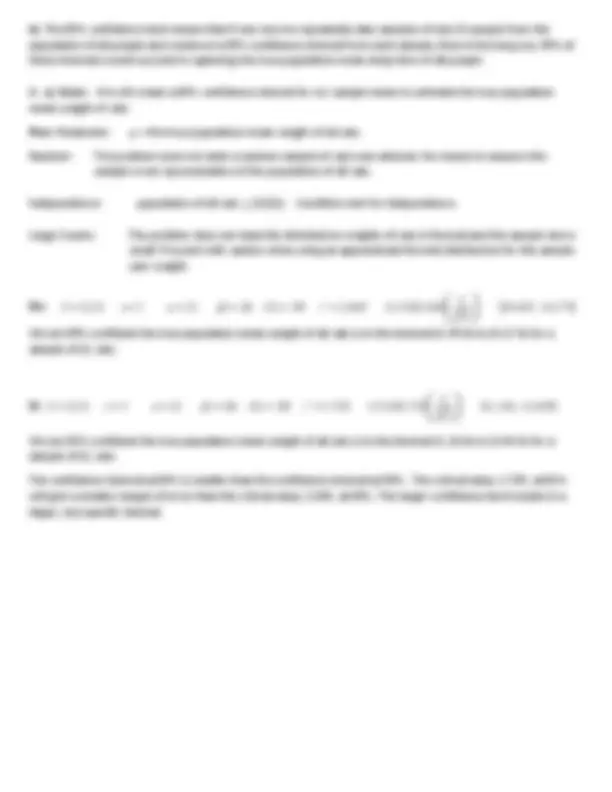



Study with the several resources on Docsity

Earn points by helping other students or get them with a premium plan


Prepare for your exams
Study with the several resources on Docsity

Earn points to download
Earn points by helping other students or get them with a premium plan
Community
Ask the community for help and clear up your study doubts
Discover the best universities in your country according to Docsity users
Free resources
Download our free guides on studying techniques, anxiety management strategies, and thesis advice from Docsity tutors
Practice problems and solutions for creating confidence intervals for one-sample proportions and means. The problems cover topics such as determining the appropriate sample size, interpreting confidence intervals, and comparing confidence intervals at different confidence levels. The document demonstrates the application of statistical concepts like random sampling, independence, and normal distribution assumptions to make inferences about population parameters. The detailed step-by-step solutions and explanations make this document a valuable resource for students studying statistical inference, hypothesis testing, and confidence interval estimation.
Typology: Thesis
1 / 2

This page cannot be seen from the preview
Don't miss anything!


1. a) State: We will create a 90% confidence interval for a 1-sample proportion to estimate the true population
proportion of beginning algebra student who did not pass.
Plan: Parameter: p = the true population proportion of beginning algebra student who did not pass.
Random: The problem states the algebra students were randomly selected.
Independence: population of all beginning algebra students > 10(300) Condition met for independence
Large Counts: np > 10 67 >10 nq > 10 233 > 10 Sample size large enough to consider
approximately Normal.
Do:
p q n se z CL
We are 90% confident the true population proportion of beginning algebra student who did not pass is in the
interval 18.2% to 26.3% for a sample size of 300 students.
b) One would need a sample size of at least 188 beginning algebra students to
obtain a margin of error of ±5% at a 90% confidence level.
2. a) State: We will create a 95% confidence interval for a 1-sample mean to estimate the true population mean
sleep time of all people.
Plan: Parameter: μ = the true population mean sleep time of all people.
Random: The problem states a random sample of people was selected.
Independence: population of all people > 10(13) Condition met for independence
Large Counts: The problem states the distribution of average hours of sleep is Normal.
x s n df CL t
We are 95% confident the true population mean sleep time of all people is in the interval 6.15 hr to 8.45 hr for a
sample of 13 people.
b) The 95% confidence level means that if one were to repeatedly take samples of size 13 people from the
population of all people and construct a 95% confidence interval from each sample, then in the long run, 95% of
these intervals would succeed in capturing the true population mean sleep time of all people.
3. a) State: We will create a 99% confidence interval for a 1-sample mean to estimate the true population
mean weight of cats.
Plan: Parameter: μ = the true population mean weight of all cats.
Random: The problem does not state a random sample of cats was selected. No reason to assume this
sample is not representative of the population of all cats.
Independence: population of all cats > 10(21) Condition met for independence
Large Counts: The problem does not state the distribution weights of cats is Normal and the sample size is
small. Proceed with caution when using an approximate Normal distribution for the sample
cats’ weight.
x s n df CL t
We are 99% confident the true population mean weight of all cats is in the interval 10.45 lb to 14.17 lb for a
sample of 21 cats.
x s n df CL t
We are 90% confident the true population mean weight of all cats is in the interval 11.18 lb to 13.44 lb for a
sample of 21 cats.
The confidence interval at 90% is smaller than the confidence interval at 99%. The critical value, 1.725, at 90%
will give a smaller margin of error than the critical value, 2.845, at 99%. The larger confidence level results in a
larger, less specific interval.